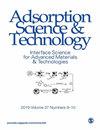Sulphuric Acid-Modified Coal Fly Ash for the Removal of Rhodamine B Dye from Water Environment: Isotherm, Kinetics, and Thermodynamic Studies
IF 3.2
4区 工程技术
Q2 CHEMISTRY, APPLIED
引用次数: 0
Abstract
Among the wide variety of dyes present in the environment, cationic dyes are more toxic and have complex structure. The adsorption process of rhodamine B dye was successfully carried out by sulphuric acid-treated inexpensive modified fly ash (MFA) adsorbent via batch experiments. The nature of the adsorbent was characterized by techniques, namely, Fourier transform infrared spectroscopy (FTIR), scanning electron microscopy (SEM), energy-dispersive X-ray spectroscopy (EDX), X-ray diffraction (XRD), and thermogravimetric analysis (TGA). The maximum removal efficiency of RhB dye was found to be 99.78% by using 0.5 g of adsorbent dosage in 50 mg/L of dye concentration. The SEM images displayed the porous nature of the adsorbent where the EDS analysis displays the elemental compositions present in the adsorbent. XRD pattern shows the crystallinity nature of the adsorbent. Among the batch study parameters, effect of pH plays an important role in the adsorption process. The pH of 4 was found to be an ideal setting for the efficient removal of the dye RhB. The preferable elimination ability was found by keeping the dosage at 5 g/L, contact time 120 min, and dye concentration at 50 mg/L. Adsorption capacity was found to be 36.36 mg/g. This shows the ability of the MFA for the removal of wastewater contaminants. This adsorption process is well suited for the Freundlich isotherm, which displaces the process as a multilayer adsorption. Studies in kinetics and thermodynamics demonstrate that the process was well suited for its exothermic nature and pseudo-second-order. Thermal regeneration studies were carried out, and the adsorbent was effectively recycled and utilized up to four more times with minimal loses in its effectiveness. Therefore, from these obtained results, it is clear that the MFA is an effective adsorbent for the effective removal of dyes from wastewater.硫酸改性粉煤灰去除水中罗丹明B染料:等温线、动力学和热力学研究
在环境中存在的多种染料中,阳离子染料毒性较大,结构复杂。通过批量实验,成功地进行了硫酸处理的廉价改性粉煤灰(MFA)吸附剂对罗丹明B染料的吸附。采用傅里叶变换红外光谱(FTIR)、扫描电镜(SEM)、能量色散x射线光谱(EDX)、x射线衍射(XRD)和热重分析(TGA)等技术对吸附剂的性质进行了表征。当吸附剂用量为0.5 g,染料浓度为50 mg/L时,对RhB染料的去除率最高可达99.78%。SEM图像显示了吸附剂的多孔性,EDS分析显示了吸附剂中存在的元素组成。XRD谱图显示了吸附剂的结晶性。在批量研究的参数中,pH的影响对吸附过程起着重要的作用。发现pH为4是有效去除染料RhB的理想环境。当用量为5 g/L、接触时间为120 min、染料浓度为50 mg/L时,去除效果较好。吸附量为36.36 mg/g。这表明MFA去除废水污染物的能力。这种吸附过程非常适合于Freundlich等温线,它取代了多层吸附过程。动力学和热力学的研究表明,该过程符合其放热性质和准二阶性。进行了热再生研究,吸附剂被有效地回收利用了四次以上,其有效性损失最小。因此,从这些得到的结果来看,很明显MFA是一种有效的吸附剂,可以有效地去除废水中的染料。
本文章由计算机程序翻译,如有差异,请以英文原文为准。
求助全文
约1分钟内获得全文
求助全文
来源期刊

Adsorption Science & Technology
工程技术-工程:化工
CiteScore
5.00
自引率
10.30%
发文量
181
审稿时长
4.5 months
期刊介绍:
Adsorption Science & Technology is a peer-reviewed, open access journal devoted to studies of adsorption and desorption phenomena, which publishes original research papers and critical review articles, with occasional special issues relating to particular topics and symposia.
 求助内容:
求助内容: 应助结果提醒方式:
应助结果提醒方式:


